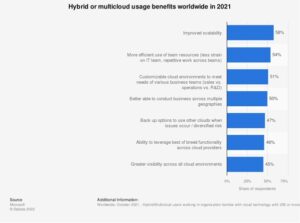
/
Benefits of Hybrid Cloud: Jumpstart Digital Transformation with HPE GreenLake x Red Hat®
HPE Advisory and Professional Services can help you address your IT challenges through placing the right technologies in the right places for success. Learn More:

As the pressure to deliver faster IT services and reduce costs mount, enterprises are looking for alternatives to rigid legacy systems. Open hybrid cloud solutions offer a much-needed respite, giving enterprises the highest flexibility to run their applications across different environments–without having to rebuild equipment, retrain people, or maintain disparate environments.
Over the last three years, the use of hybrid and multi cloud technology has increased by over 60 percent, as companies sought for a high degree of flexibility to cope with changes in work and inconsistencies in demand. By 2025, 89% of organisations are likely to use hybrid services.
However, for most enterprises, adopting open hybrid cloud technologies can be daunting and confusing. This is where the HPE GreenLake with Red Hat® partnership comes in.
Expanding on 20 years of pioneering open-source technologies for modern data centres, HPE GreenLake and Red Hat® now offer the flexibility of open-source solutions combined with hybrid cloud leadership.
In this article, we explore the benefits of hybrid cloud and how HPE GreenLake and Red Hat® can help you transform your digital stack.
Why Open Hybrid Cloud?
The hybrid cloud model consists of storage and computing systems that combine both on-premises infrastructures with either private or public cloud infrastructure. This gives you the best of both worlds – you can scale up easily with public cloud resources during peak demand while maintaining sensitive data and compliance-related workload on-premises.
For instance, a data centre could reap the speed and efficiency benefits of cloud computing while still compartmentalising certain operations to the on-premises network. This would achieve a cost-effective compromise between the security of on-premises data centres and faster speeds of cloud resources.
Open hybrid cloud offers an additional layer of flexibility. With Red Hat®’s open hybrid cloud, you can run any application or workload consistently across any footprint, including on-premises, at the edge, and in the cloud. Quickly build, deploy, and manage applications while simplifying, automating, and securing processes.
Red Hat®’s open hybrid cloud infrastructure is built on the technological foundation of Red Hat® Enterprise Linux, Red Hat® OpenShift, and Red Hat® Ansible Automation Platform.
This strategy gives developers within your organisation a common application environment to develop, orchestrate, and run their applications, while giving sysadmins and operations teams a common operating environment to manage their infrastructure.
Why is hybrid cloud so appealing to enterprises? Let’s explore the main benefits you can stand to gain from adopting hybrid cloud.
Unlocking the Benefits of Hybrid Cloud: Why it’s time to make the switch
The biggest benefit of hybrid cloud is improved scalability, according to global respondents in a 2021 Microsoft study. Other benefits include more efficient use of team resources, customisable cloud environments, and the ability to conduct business across multiple geographies. Let’s explore each in detail.

Source: Statista
1. Improved scalability
With a hybrid cloud, you can scale resources up and down as needed. Go from 10 servers to a thousand within minutes!
In the traditional ecosystem, you’d have to purchase additional servers and on-premises equipment wherever you wanted to scale up during peak season. This could take days and even months, and can cost you thousands of dollars.
But with hybrid cloud environments, you can scale up from zero servers to a thousand and then back to zero within a short period of time. Add or remove as many servers as you want instantly to keep up with spiked demands.
What’s more, you can also configure your data centre to automatically adapt to changes in the traffic and add or remove servers according to the volume of traffic.
Such a high degree of scalability means companies can deliver faster speed-to-market, reduce costs, and improve the performance of critical workloads.
2. Flexibility
For fast-paced companies that can’t afford to have a single point of failure, whether that’s private cloud services or on-premises networks, hybrid cloud comes with a lot of flexibility.
If something goes wrong with your on-premises IT infrastructure, you could use cloud migration to move your operations to various apps that will keep the business running until local systems are back online. This makes the hybrid cloud strategy a boon for disaster recovery and business continuity.
With hybrid cloud you will also be able to set up servers in any location in the world, allowing global companies to serve customers in any market. In fact, you can set up servers close to your location to save costs while enjoying faster speed.
For instance, HPE GreenLake’s cloud solution comes with built-in flexibility so you can start from anywhere and put workloads where they make the most sense.
3. Cost savings
In a hybrid cloud model, you only need to pay for the resources you actually use. This eliminates the need for large upfront investments in infrastructure and reduces ongoing maintenance and management costs.
In addition, the ability to scale resources up or down means you won’t be overspending on unused capacity. Hybrid cloud technologies like HPE GreenLake charges you via a pay-per-use model so you will never need to pay more than you need.
Another indirect factor of cost savings is resource pooling.
Hybrid cloud services allow you to combine and share IT resources across multiple environments, including on-premises infrastructures and public cloud resources. This creates a shared resource pool that can be used by different applications and workloads, reducing costs and optimising resource allocation.
4. Automation
There’s no question that the automated orchestration of recurring tasks or workflows can save your company countless dollars and boost productivity in the long run. Fortunately, hybrid cloud computing is one of the fastest and most reliable ways to leverage automation in your business.
For instance, the Red Hat® Ansible® hybrid cloud automation platform standardises automation across the organisation by connecting users across any IT domain or infrastructure, helping eams streamline and provide governance for over a dozen use cases.
5. Enhanced Security
Cloud security tends to always be one step ahead of the cybersecurity protocols you’d find in on-premises solutions and locally-installed software.
This is especially true when looking at data security on hybrid environments and comparing them to the equivalent on-premises solutions.
After all, giants like Microsoft Azure, Amazon Web Services, and Google Workspace are constantly investing billions of dollars to improve security on their cloud platforms. This means that exploits or security risks on public cloud environments are going to be found quicker and patched sooner.
In general, cloud storage also tends to reduce latency when sharing files and conserves local computing resources since employees won’t need to constantly upload documents just to send them as an attachment — making your system both faster and safer.
For instance, Red Hat® OpenShift, a unified cloud-native platform, helps organisations build, modernise, and deploy applications in the most secure and efficient means possible. It offers features like continuous integration and release management while supporting multiple environments.
HPE GreenLake understands the importance of security, which is why we built security into all our products to help protect your digital supply chain. Together with Red Hat®, an equal partner in security, we are providing the most flexible and secure open hybrid cloud solutions for modern enterprises.
Fast-Forwarding Digital Transformation with HPE GreenLake and Red Hat®
One of the biggest hurdles to digital transformation is the confusion around which hybrid cloud technologies to adopt for greater flexibility, improved performance, and stronger security.
HPE GreenLake with Red Hat® helps ease this pain. We provide trusted infrastructure solutions for physical, virtual, and hybrid cloud environments that empower your organisation to keep pace with customer demands and competitor advancements.
Through this partnership, you can add any Red Hat® products including Red Hat® Enterprise Linux, hybrid cloud, automation, and storage technologies to HPE GreenLake projects on a pay-as-you-go basis.
90% of Fortune 500 companies already trust Red Hat®’s catalogue of open-source solutions and their track record for success in businesses of all sizes. And these companies have seen 20% higher developer productivity, 71% less unplanned downtime, and 636% ROI over five years.
With Red Hat® OpenShift, your business can automatically scale resources, applications and workflows. In conjunction with HPE GreenLake, capacity can also be scaled to support workloads, allowing you to rapidly increase or decrease compute and storage whenever you need to.
And all this can be accomplished with fully managed cloud services from HPE designed to deliver a cloud-consumption model that saves time and money.
Ready to jumpstart your digital transformation journey?
The HPE GreenLake with Red Hat® partnership aims to help mid-market, enterprise, and government organisations modernise IT and advance their digital transformation.
By upgrading legacy systems to new cloud-native applications running in a multi cloud environment (both private and public), you can speed innovation cycles and deliver the products and services your customers demand, while reducing costs and securing your organisation.
Achieve your cloud, your way, with a unified experience across edge to cloud—and gain more flexibility and scalability by leveraging Red Hat® leadership in open source and hybrid cloud.
Ready to get started? Book a free discovery session with our architects and we’ll set up a workshop tailored to your individual requirements.

